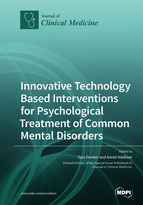Innovative Technology Based Interventions for Psychological Treatment of Common Mental Disorders
A special issue of Journal of Clinical Medicine (ISSN 2077-0383).
Deadline for manuscript submissions: closed (31 December 2019) | Viewed by 45849
Special Issue Editors
Interests: early intervention and prevention of depression, anxiety and suicide, based on innovative technologies such as virtual reality and mobile apps
Interests: e-mental health; depression; meta-analysis; anxiety; cognitive therapy; delivery of health care
Special Issue Information
Dear Colleagues,
Mental health disorders such as depression, anxiety and other stress-related disorders are highly prevalent or even increasing globally while access to evidence-based therapy is still limited. Worryingly, health care budgets are further restrained, thus limiting the availability of mental health care even more. Innovative technologies aiming to increase scalability, accessibility and cost-efficiency of evidence-based mental health treatment, or target hard-to-reach populations, show promising solutions to prevent or treat such disorders. However, despite considerable progress in this area, more research into innovative technologies and its implementation in mental health care is needed to treat people with, or prevent, mental health disorders. The present Special Issue aims to provide an overview of the latest innovative technological advances in the screening and treatment of mental health, as well as their implications for mental health care. Both original research and review papers will inform researchers and clinicians with recent knowledge on innovative technology in the area of psychological treatments of common mental disorders e-mental health.
Dr. Tara Donker
Dr. Annet Kleiboer
Guest Editors
Manuscript Submission Information
Manuscripts should be submitted online at www.mdpi.com by registering and logging in to this website. Once you are registered, click here to go to the submission form. Manuscripts can be submitted until the deadline. All submissions that pass pre-check are peer-reviewed. Accepted papers will be published continuously in the journal (as soon as accepted) and will be listed together on the special issue website. Research articles, review articles as well as short communications are invited. For planned papers, a title and short abstract (about 100 words) can be sent to the Editorial Office for announcement on this website.
Submitted manuscripts should not have been published previously, nor be under consideration for publication elsewhere (except conference proceedings papers). All manuscripts are thoroughly refereed through a single-blind peer-review process. A guide for authors and other relevant information for submission of manuscripts is available on the Instructions for Authors page. Journal of Clinical Medicine is an international peer-reviewed open access semimonthly journal published by MDPI.
Please visit the Instructions for Authors page before submitting a manuscript. The Article Processing Charge (APC) for publication in this open access journal is 2600 CHF (Swiss Francs). Submitted papers should be well formatted and use good English. Authors may use MDPI's English editing service prior to publication or during author revisions.
Keywords
- Common mental disorders (i.e., depressive disorder, anxiety disorders, addiction)
- Innovative technology
- Internet interventions
- Mobile applications
- Ecological momentary assessments
- Virtual reality
- Prevention
- Intervention
- Screening







